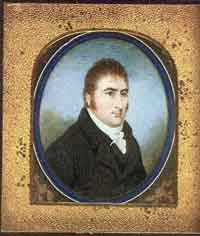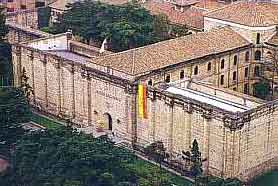|
National Museum of Colombia in Bogotá
Among the
many fascinating museums dotted around Bogotá, the capital
city of Colombia, is the Museo Nacional
[1] located in the
international centre on Carrera 7ª. This institution was
founded in 1823 and is one of the oldest of its kind in
America. The museum now occupies a unique building often
referred to as El Panóptico.
[2] For over seventy-two
years this building served as the principal penitentiary in
Colombia.
The prison
was designed by the Danish architect Tomás Reed,
[3] who
arrived in Bogotá from Caracas, Venezuela, in 1847 at the
behest of the Colombian president Tomás Cipriano de Mosquera.
[4] Reed was invited to occupy the chair of architecture at
the Universidad Central and offered instruction in building
design and construction techniques. Entrusted with drawing up
a design for a new prison in Bogotá as well as the design for
the Capitolio parliament building, Reed submitted his plans by
1852 but had left the country before actual construction
commenced in 1874. Almost thirty years later, the construction
of the prison was completed. Such was the excellence and
flexibility of Reed’s design that it elicited the admiration
and approval of Le Corbusier when the French architect visited
Bogotá in 1947. Reed’s original plans and drawings are
preserved in the Colombian National Archives.
Reed’s
contract was renewed in 1848 and included the design of the
Capitolio. He presented his design to Congress and from the
tone of his presentation it was obvious that he considered
this to be his most significant project. He was to be greatly
disappointed when construction ceased shortly after the
foundations had been laid. Reed was an urbane, freethinking
and cultured individual who combined his architectural
activities with other cultural interests. He was joint founder
of the Philharmonic Society where he played the violin.
Construction began on his neo-classical designs for the
Philharmonic Society building, but was never completed. Like
those of the Capitolio, its partially built walls remained in
ruins for many years.
Reed’s
design for the Panóptico was based on the layout of a
structure in Philadelphia. It remained in planning stages and
only came to fruition between 1874 and 1881, incorporating
changes made by the contractor Francisco Olaya. In Colombia,
Reed built two bridges over Bogotá’s streets, reconstructed
another over the River Apulo, built several houses and
remodelled the cloister of Santo Domingo to adapt it for use
as public offices, converting 'the aged and austere colonial
construction into an elegant palace to modern tastes.
[5]
Frustrated, impatient and convinced that his greatest work
would never be built, Reed decided to move to Quito in 1855 on
receipt of an invitation from the president of Ecuador. He
married and continued his architectural pursuits with major
projects such as another penitentiary, the cathedral and the
Governor’s Palace. He spent his final years on a private
estate and died in Guayaquil in south-west Ecuador.
Reed would
have been amazed to see the transformation of this structure
from penitentiary to museum. Prisoners were transferred to the
new Cárcel de la Picota in 1946. Following two years of
refurbishment, the museum opened at its new home in 1948.
The
museum holds over 20,000 individual artefacts including art
collections, paintings, portraits, furniture, busts, statues,
military regalia, as well as items of historical, ethnographic
and archaeological interest. In this collection there are some
items of Irish interest, nearly all of them relating to the
Colombian War of Independence.
[6] Some of these items have
been reproduced in Matthew Brown and Martín Alonso Roa’s
lavishly illustrated new book.
[7] The exhibits of Irish
interest in the museum are detailed in what follows.
(a)
Daniel Florence O´Leary
[8]
A
Davenport mahogany writing desk
[9] made in England by James
Winter. [10] c.1835. Reg. No. 2710. 90.5 x 59 x 60 cm.
Acquired by the Beatriz Osorio Foundation
[11] from the Cantillo O’Learys, great granddaughters of Daniel Florence
O’Leary, in 1971 for the Museo Nacional (Brown and Alonso Roa
reproduction p. 255). [12]
(b)
Daniel Florence O´Leary
A cut away
'superfin riche' [sic]
[13] military jacket made from
carded wool, using metal thread, sequins, silk, leather and
velvet materials. Metal buttons. C.1835. Casa Museo
collection. [14] Reg. No. 3454. (Brown and Alonso Roa
reproduction p. 251).
|

Jeremías
O'Leary, ca. 1835
(Catálogo de Miniaturas, 1993) |
(c)
Jeremías O´Leary
Anonymous
portrait. [15] Miniature on ivory. c.1835. English school.
Reg. No. 2712. 7.5 x 6 cm. Acquisition in 1971 as per (a)
above.
(d)
Jeremías O´Leary Burke [?]
Brother of
Florence O´Leary Burke. [16] Anonymous portrait. Miniature.
c.1835. Reg. No. 2713. 6 x 5 cm; oval. Acquisition in 1971 as
per (a) above.
(e)
Daniel Florence O´Leary
Anonymous
portrait. Miniature on ivory. c.1835. English school. Reg. No.
2714. 7 x 5.8 cm; oval. (Brown and Alonso Roa reproduction p.
233). [17]
(f)
Daniel Florence O´Leary
Anonymous
portrait. c.1840. Reg. No. 2715. 66 x 55 cm; oval. Acquisition
in 1971 as per (a) above.
[18]
(g)
Daniel Florence O´Leary
English-made collapsible bed and associated wooden carrying
case. [19] c.1825. Casa Museo Collection.
[20] Reg. No. 4108
(Brown and Alonso Roa reproduction p.240).
(h)
Elvira Tanco de Malo O´Leary
[21]
Oil on
cloth portrait by Epifanio Garay Caicedo.
[22] c.1900. Reg.
No. 2765. 125 x 98 cm. Wife of Arturo Malo O´Leary, Daniel
Florence O’Leary’s nephew. Acquired for the Museo Nacional
between 1972 and 1976 by the Beatriz Osorio Foundation.
|

Daniel Florencio
O'Leary Burke, ca. 1835
(Catálogo de Miniaturas, 1993)
|
(i)
Joseph Boylan [23]
Portrait
of a man/Joseph Boylan by José María Espinosa.
[24] c.1831.
Miniature. Reg. No. 4560. Acquired in Caracas in 1978 by
Carlos Duarte from the widow of Edbert E. Boylan on behalf of
the Beatriz Osorio Foundation for the Museo Nacional, 15
November 2001.
(j)
Robert Lee
Oil on
cloth portrait by José Eugenio Montoya.
[25] c.1890. Reg. No.
225. Legend on the painting states 'Robert Lee, Irlandés prócer de la Independencia. Murió 20 Febrero 1854' (Robert
Lee, Irish man, leader of Independence. Died 20 February
1854). Donated to the Museo Nacional by Robert Lee Franco, 3
July 1891 (Brown and Alonso Roa reproduction p. 248).
(k)
James Rooke [26]
Wooden
bench. Maker anonymous. c.1819. Reg. No. 2559. This was the
bench on which Rooke was attended to by Surgeon Thomas Foley
and died, after the battle at Pantano de Vargas (Brown and
Alonso Roa reproduction p. 234). Mentioned in the Nueva
Guía descriptiva
del Museo
de Bogotá (1886).
|




